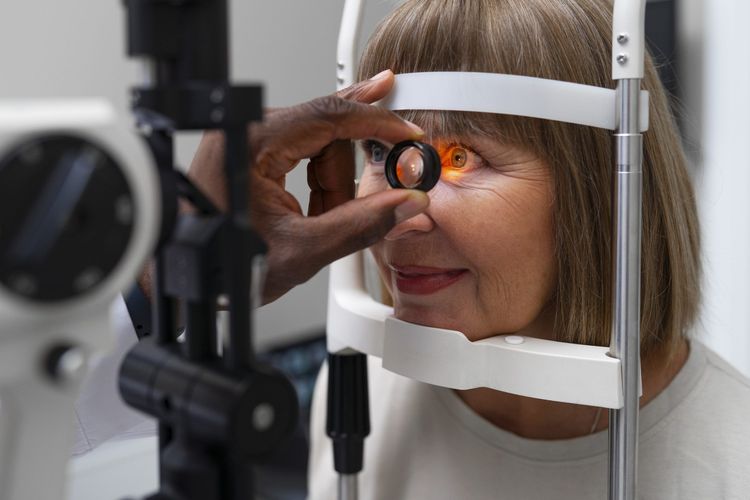Macular degeneration challenges millions with progressive vision loss. Advances in research are redefining treatment options, promising hope and improved quality of life for affected individuals. Innovations in science and technology are reshaping our understanding and management of this condition.
Understanding Macular Degeneration
Macular degeneration, particularly age-related macular degeneration (AMD), affects the central portion of the retina known as the macula. The condition manifests primarily in two forms: dry and wet. The dry form is characterized by the gradual thinning of the macula, while the wet form involves abnormal blood vessel growth that can leak fluid, leading to rapid vision loss. Understanding the underlying mechanisms is critical to developing effective treatments.
The Impact on Vision and Daily Life
Individuals with macular degeneration face challenges in activities that require sharp vision—reading, driving, and recognizing faces become increasingly difficult. This condition not only affects the eyes but also imposes psychological burdens including anxiety and depression. Addressing these challenges requires comprehensive care that extends beyond clinical treatments to encompass support services and lifestyle modifications.
Current Standard Approaches
Traditional treatment methods primarily focus on managing symptoms and slowing disease progression. Nutritional supplementation, lifestyle changes, and, in cases of wet AMD, procedures to manage abnormal blood vessel growth are standard practices. However, these methods do not reverse vision loss, highlighting the urgent need for innovative therapies that target the root causes of the degeneration process.
Emerging Therapeutic Approaches
Advances in technology and biological science have paved the way for new treatments that promise to modify the disease process rather than simply manage symptoms. Researchers are exploring various strategies that harness the body’s natural repair mechanisms or intervene at the genetic level.
Gene Therapy: Rewriting the Blueprint
Gene therapy is emerging as a promising frontier in the treatment of macular degeneration. This approach involves delivering genetic material directly to the retinal cells to correct or compensate for the defective genes responsible for the condition. Early clinical trials are showing that introducing therapeutic genes can potentially slow or halt disease progression by targeting cellular pathways involved in retinal degradation.
Mechanisms and Delivery Methods
The delivery of genetic material is often achieved using viral vectors that have been engineered for safety and specificity. These vectors transport the corrective genes directly to the retinal tissue. While challenges such as immune responses and ensuring precise gene expression remain, continuous improvements in vector design and delivery techniques are enhancing the efficacy and safety profile of gene therapy.
The Role of Personalized Medicine
Gene therapy is inherently linked with personalized medicine. By analyzing a patient’s genetic profile, clinicians can tailor treatments that address specific genetic mutations contributing to the disease. This personalized approach not only improves outcomes but also minimizes potential side effects by targeting only the malfunctioning components within the retinal cells.
Stem Cell Therapies: Regenerating Vision
Stem cell therapy offers another groundbreaking approach by aiming to replace or repair damaged retinal cells. Researchers are exploring the use of pluripotent stem cells—cells that have the potential to differentiate into various cell types—to regenerate the macula’s essential structures.
Types of Stem Cells in Research
Several types of stem cells are under investigation:
- Embryonic Stem Cells (ESCs): These cells have the highest potential for differentiation but raise ethical and regulatory issues.
- Induced Pluripotent Stem Cells (iPSCs): These are adult cells reprogrammed to behave like embryonic stem cells. iPSCs offer a promising alternative as they can be derived from the patient’s own tissue, reducing the risk of rejection.
- Adult Stem Cells: Harvested from various tissues, these cells are more limited in differentiation but present fewer ethical concerns and have already shown promise in early clinical studies.
Challenges and Advances
One of the primary challenges of stem cell therapy is ensuring that the transplanted cells integrate properly into the existing retinal tissue and function as intended. Advances in cell culture techniques, biomaterials for scaffolding, and controlled differentiation protocols are gradually overcoming these hurdles. Researchers are also working on methods to protect the transplanted cells from the harsh environment of a diseased retina, enhancing their survival and function.
Novel Device Innovations
While biological approaches offer a path to regeneration, technological innovations are providing immediate support to those suffering from vision loss. New devices are designed to improve quality of life and sometimes even enhance residual vision.
Implantable Electronic Devices
Implantable electronic devices, such as retinal implants, work by bypassing damaged photoreceptors and directly stimulating the remaining retinal cells. These devices convert visual information captured by an external camera into electrical signals, which are then transmitted to the brain. Although these systems currently offer limited resolution, continuous improvements in electronics, power management, and miniaturization are promising for future enhancements.
Assistive Technologies
Beyond implants, assistive technologies like smart glasses and advanced image processing software are transforming how individuals with macular degeneration interact with the world. These devices help magnify images, enhance contrast, and even translate visual cues into auditory signals. Such innovations empower patients by improving their ability to navigate daily environments independently.
Complementary and Lifestyle Approaches
While breakthrough treatments promise to transform the management of macular degeneration, lifestyle factors remain integral to overall eye health. Research has shown that nutritional factors, physical activity, and environmental adjustments can complement emerging therapies.
Nutrition and Antioxidant Intake
Nutritional interventions continue to be a cornerstone in managing macular degeneration. Diets rich in leafy greens, omega-3 fatty acids, and other antioxidants can provide supportive benefits to retinal health. These dietary strategies may help reduce oxidative stress—a key factor in the progression of the disease. Although not a standalone cure, proper nutrition can enhance the effectiveness of other treatments and slow disease progression.
The Role of Physical Activity
Regular physical activity has been linked to improved vascular health and reduced inflammation, both of which are beneficial for maintaining retinal integrity. Exercise not only contributes to overall well-being but also aids in maintaining optimal blood flow to the eyes, which is crucial for preserving vision.
Psychological Support and Rehabilitation
Dealing with a progressive vision loss condition like macular degeneration can be emotionally challenging. Psychological support, including counseling and peer support groups, is essential for helping patients adjust to changes in their vision. Rehabilitation services, including vision therapy and adaptive training, can assist patients in maximizing their remaining vision and maintaining independence.
Clinical Trials and Research Initiatives
Clinical trials are at the forefront of translating laboratory discoveries into practical therapies. Researchers across the globe are conducting rigorous studies to evaluate the safety and efficacy of new treatments for macular degeneration.
The Structure of Clinical Trials
Clinical trials are structured in multiple phases:
- Phase I: Focuses on safety and dosage.
- Phase II: Evaluates the efficacy and further assesses safety.
- Phase III: Involves large-scale testing to confirm effectiveness, monitor side effects, and compare with standard treatments.
- Phase IV: Conducted after approval to monitor long-term effects in the general population.
Participation in clinical trials not only advances scientific knowledge but also provides patients with access to cutting-edge treatments that might not yet be available in mainstream clinical practice.
Global Collaborations
The complexity of macular degeneration research necessitates international collaboration. Multicenter trials and partnerships between academic institutions, research centers, and industry are accelerating the development of new therapies. Such collaborations foster an environment where data sharing and combined expertise lead to breakthroughs that would be challenging to achieve in isolation.
Ethical and Regulatory Considerations
With innovative treatments come important ethical and regulatory challenges. Ensuring that new therapies are safe, effective, and accessible is paramount. Regulatory bodies are working closely with researchers to establish guidelines that protect patients while promoting rapid advancements in treatment options. Transparency in clinical trial processes and results is critical for building public trust and ensuring that ethical standards are upheld throughout the research process.
The Future of Macular Degeneration Treatments
As science continues to push the boundaries of what is possible, the future of macular degeneration treatment is promising. Emerging therapies aim not only to slow the progression of the disease but also to restore vision lost to degeneration.
Integration of Advanced Technologies
The integration of artificial intelligence (AI) and machine learning in diagnostics and treatment planning is poised to revolutionize eye care. AI-driven imaging techniques can detect subtle changes in retinal structure before clinical symptoms become apparent, enabling earlier intervention. Personalized treatment plans based on AI analysis of patient data may lead to better outcomes and more efficient allocation of healthcare resources.
The Promise of Regenerative Medicine
Regenerative medicine holds significant promise for restoring vision. Combining gene therapy with stem cell approaches could potentially repair and regenerate damaged retinal tissues. Although these treatments are still in experimental stages, the rapid pace of research suggests that they may become viable options within the next decade.
Patient-Centered Care Models
Future treatment paradigms will likely emphasize patient-centered care. This model integrates cutting-edge medical interventions with comprehensive support services, ensuring that patients receive not only the best possible medical treatment but also the emotional and practical support necessary to navigate the challenges of vision loss. Multidisciplinary teams consisting of ophthalmologists, geneticists, nutritionists, and rehabilitation specialists will work collaboratively to provide holistic care tailored to individual needs.
Challenges and Considerations
Despite the tremendous progress, several challenges remain in the journey toward fully effective treatments for macular degeneration.
Biological Barriers
The human eye is a complex organ with protective barriers that can complicate the delivery of therapeutic agents. Overcoming these barriers requires innovative solutions, such as improved drug delivery systems that can safely and effectively transport therapeutic molecules directly to the retina.
Economic and Accessibility Issues
The development of advanced treatments, especially those involving gene therapy or stem cell interventions, can be expensive. Ensuring that these therapies become accessible to a broad population is a significant concern. Efforts are underway to streamline manufacturing processes and reduce costs while maintaining high safety and efficacy standards.
Long-Term Efficacy and Safety
Any new treatment must be thoroughly evaluated for long-term efficacy and potential adverse effects. Ongoing monitoring and post-market surveillance are essential to ensure that the benefits of emerging therapies continue to outweigh any risks. Researchers and regulatory agencies are committed to conducting long-term studies that provide comprehensive safety profiles for new interventions.
Integrating Innovations with Traditional Care
The promising new treatments for macular degeneration are not meant to replace established care practices but rather to complement them. For example, nutritional support and lifestyle modifications continue to play a vital role even as more sophisticated therapies are developed. By integrating traditional care with advanced medical interventions, healthcare providers can offer a more comprehensive treatment strategy that addresses both the symptoms and the underlying causes of macular degeneration.
Collaborative Care Teams
The future of macular degeneration treatment lies in collaborative care models. Ophthalmologists, genetic counselors, nutritionists, and rehabilitation experts form integrated teams that work together to create individualized treatment plans. This multidisciplinary approach ensures that patients receive the benefits of advanced therapies while also addressing the broader aspects of their health and well-being.
Patient Education and Engagement
Educating patients about the available treatment options and encouraging active participation in their care are crucial. Empowered patients who understand their condition and the rationale behind their treatment plans tend to experience better outcomes. Healthcare providers are increasingly emphasizing patient education, using clear and accessible language to explain complex treatments and the importance of lifestyle modifications.
Looking Ahead: Hope on the Horizon
The landscape of macular degeneration treatment is evolving rapidly. As researchers continue to explore innovative therapies, the prospects for slowing or even reversing the course of the disease are brighter than ever. This progress, however, is the result of years of dedicated research, extensive clinical trials, and a commitment to understanding the intricacies of the human eye.
The Role of Ongoing Research
Ongoing research efforts are critical to sustaining the momentum in developing new treatments. Funding from government agencies, private foundations, and international partnerships is essential to drive these initiatives forward. Researchers remain cautiously optimistic, emphasizing that while the challenges are significant, the potential benefits for patients are transformative.
Community and Advocacy
Patient advocacy groups and community organizations play a vital role in supporting research and raising awareness about macular degeneration. These groups not only help disseminate information about the latest treatment advancements but also provide a support network for those affected by the condition. Advocacy efforts continue to influence research funding priorities and ensure that patient voices remain central in the development of new therapies.
Conclusion
New treatments for macular degeneration represent a convergence of advanced science, innovative technology, and compassionate patient care. From gene therapy and stem cell interventions to cutting-edge device innovations and lifestyle strategies, the future of managing this challenging condition is filled with promise. Although challenges remain in ensuring accessibility and long-term efficacy, the continuous evolution of research and clinical practice offers hope for improved vision and quality of life for countless individuals.
It is important to note that while the advancements discussed here are promising, the field is evolving rapidly. Patients should consult with their healthcare providers to determine the best course of treatment based on the latest research and their individual health needs. As ongoing studies further illuminate the potential of these innovative approaches, there is growing optimism that effective solutions for macular degeneration will soon be within reach, empowering patients to maintain their vision and independence.
This exploration of emerging treatments underscores the transformative potential of combining novel therapies with comprehensive, patient-focused care. With continued collaboration among researchers, clinicians, and advocacy groups, the journey toward preserving and restoring vision for those affected by macular degeneration is gaining momentum—paving the way for a future where sight loss may be met with effective, personalized interventions that truly change lives.




